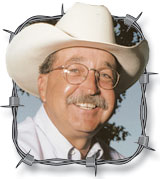Farm fences are vastly better constructed today than they were 70 years ago. Today’s fences are likely to have metal pipes for the corners and braces that have been driven deep into the ground with the hydraulic force of a 100 HP machine. Steel T-posts, spaced every 10 to 12 feet apart, support the wires that are stretched so tight they could play a tune if strummed.
When I was a kid, the best corner posts were wooden, placed in a hand-dug hole, and either tamped in with big rocks or (if you had enough money) set in concrete. Where I grew up, the line posts were usually split oak or cedar, sharpened on one end with an ax, and driven into the earth with a 16-pound maul swung by a strong man. The wire was stretched as tight as one man could get it, using a block and tackle device. If it played a tune – it would sound pretty flat.
Since almost no one had great fences, seeing cattle on the roadway was about as common as seeing indecisive, flattened squirrels. Despite every farmers’ best intentions, there were always some animals that could seemingly find a way to reach that proverbial greener grass. Dad didn’t have much patience with the chronic escapees.
Sometimes, cattle would discover their inherent super-cow ability to jump tall fences in a single bound. For the jumpers, Dad would direct them to jump into the bed of a 1952 Chevy truck with 6-foot-tall racks and then allow them to jump out at the unloading bay of the local auction barn. I can remember him saying, “I hate to see the old girl go, but I can’t help her if I can’t keep her home.”
There were cows, however, that chose to take the lower route to greener pastures by contorting their bodies to go under the fence. While on her front knees, one cow, in particular, would start by putting her head under the bottom wire and methodically push until she managed to get her entire body to the freedom of the other side. All of our cows were named, but I can only remember the adjectives that my father used preceding their names.
Instead of selling the crawlers with the jumpers, Dad used a method that was quite common in the Ozark hills of the last century. He would cut a green, forked limb from an oak sapling and place it on the roguish cow (his description). The limb would resemble the letter Y so that the solid part of the bottom would hang about two feet below the neck of the cow. As she moved along, the bottom part would flex between her front legs to not hinder her walking. Over the top of the cow’s neck and connecting the two upper parts of the Y, Dad would fashion a leather strap that could be tightened or loosened, depending on the size of the cow. Once attached, the limb would protrude to about a foot above the old girl’s head. This device permitted the cow to graze normally, nurse her calf with no problems, allow her to reproduce, and would ingeniously prevent her from crawling under any fence, no matter how poorly I had constructed it. With a little luck, the cow would be retrained in two or three weeks, and the yoke could be removed.
Dad’s yoke, as I remember, had saved many a cow on the Crownover farm from an early exit from our place to accept the same fate that had befallen their jumping cohorts.
Jerry Crownover farms in Lawrence County. He is a former professor of Agriculture Education at Missouri State University, and is an author and professional speaker. Jerry’s daily exploits on the farm are now viewable on YouTube at “lifeissimple678”. To contact Jerry, go to ozarksfn.com and click on ‘Contact Us.’







